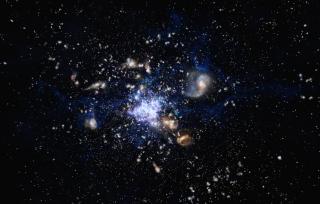Bibcode
Zhou, L.; Wang, T.; Daddi, E.; Coogan, R.; Sun, H.; Xu, K.; Arumugam, V.; Jin, S.; Liu, D.; Lu, S.; Sillassen, N.; Wang, Y.; Shi, Y.; Zhang, Z.; Tan, Q.; Gu, Q.; Elbaz, D.; Le Bail, A.; Magnelli, B.; Gómez-Guijarro, C.; d'Eugenio, C.; Magdis, G.; Valentino, F.; Ji, Z.; Gobat, R.; Delvecchio, I.; Xiao, M.; Strazzullo, V.; Finoguenov, A.; Schinnerer, E.; Rich, R. M.; Huang, J.; Dai, Y.; Chen, Y.; Gao, F.; Yang, T.; Hao, Q.
Bibliographical reference
Astronomy and Astrophysics
Advertised on:
4
2024
Journal
Citations
18
Refereed citations
13
Description
The study of distant galaxy groups and clusters at the peak epoch of star formation is limited by the lack of a statistically and homogeneously selected and spectroscopically confirmed sample. Recent discoveries of concentrated starburst activities in cluster cores have opened a new window to hunt for these structures based on their integrated IR luminosities. Here, we carry out a large NOEMA (NOrthern Extended Millimeter Array) program targeting a statistical sample of infrared-luminous sources associated with overdensities of massive galaxies at z > 2, the Noema formIng Cluster survEy (NICE). We present the first result from the ongoing NICE survey, a compact group at z = 3.95 in the Lockman Hole field (LH-SBC3), confirmed via four massive (M⋆ ≳ 1010.5 M⊙) galaxies detected in the CO(4-3) and [CI](1-0) lines. The four CO-detected members of LH-SBC3 are distributed over a 180 kpc physical scale and the entire structure has an estimated halo mass of ∼1013 M⊙ and total star formation rate of ∼4000 M⊙ yr−1. In addition, the most massive galaxy hosts a radio-loud active galactic nucleus with L1.4 GHz, rest = 3.0 × 1025 W Hz−1. The discovery of LH-SBC3 demonstrates the feasibility of our method to efficiently identify high-z compact groups or cluster cores undergoing formation. The existence of these starbursting cluster cores up to z ∼ 4 provides critical insights into the mass assembly history of the central massive galaxies in clusters.
Related projects

Molecular Gas and Dust in Galaxies Across Cosmic Time
Two of the most fundamental questions in astrophysics are the conversion of molecular gas into stars and how this physical process is a function of environments on all scales, ranging from planetary systems, stellar clusters, galaxies to galaxy clusters. The main goal of this internal project is to get insight into the formation and evolution of
Helmut
Dannerbauer